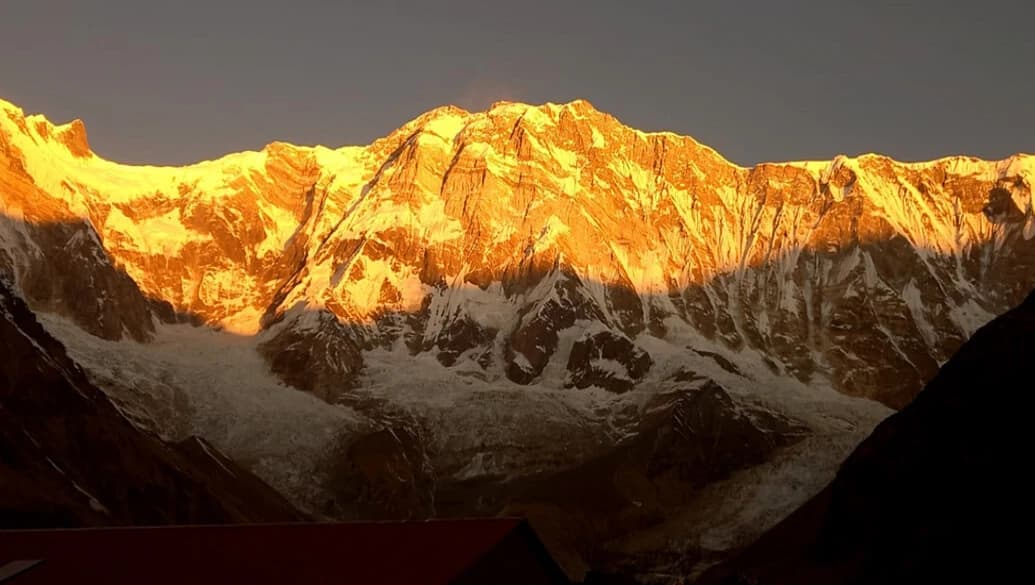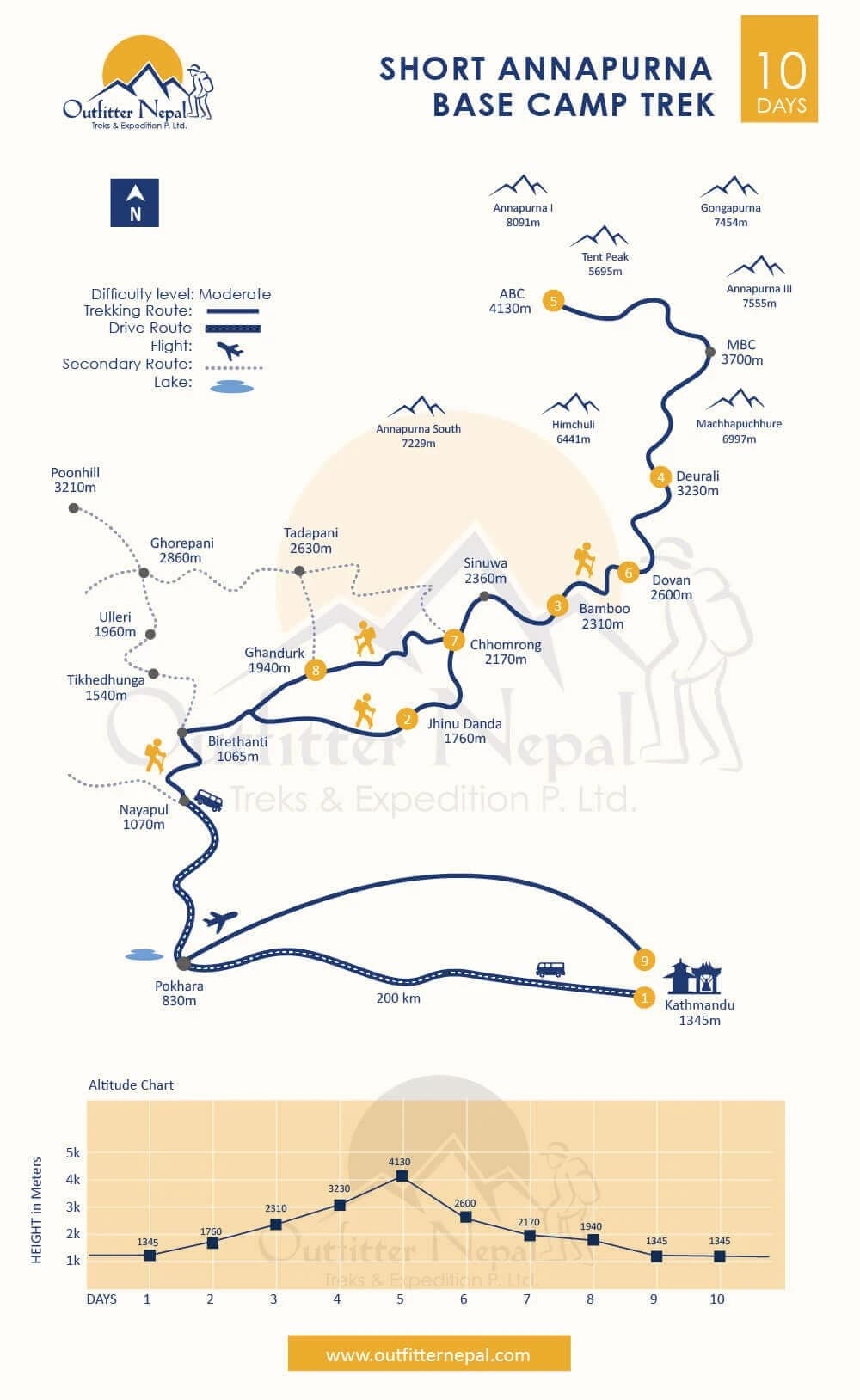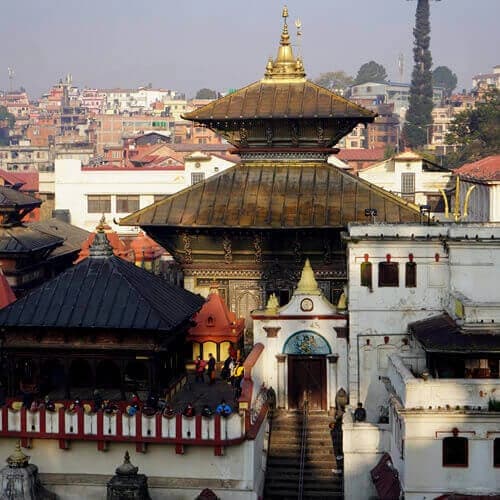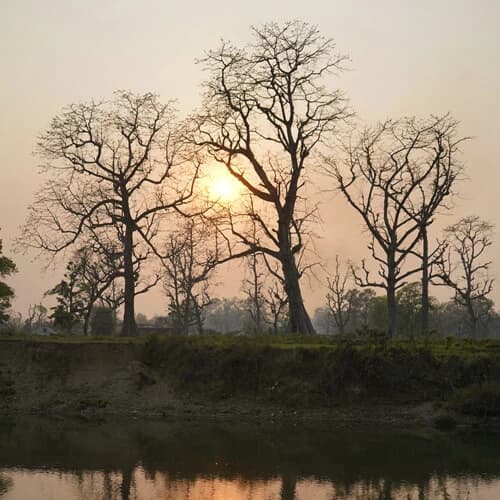Best Features of the 10 Days Annapurna Base Camp Trek
- Trek through enchanting Rhododendron and bamboo forests
- Reach the foothills of the world's 10th-highest mountain peak
- Spend the night at the incredible Annapurna Base Camp
- Hike through the rich vegetation of the Annapurna Conservation area
- Enjoy the magnificent Himalayan landscape with snow-capped mountains
- Take a dip at Jinu Danda hot spring
- Visit Gurung Village of Chhomrong and Ghandruk
- Interact with the friendly locals in their heaven-like village setting
10 Days Annapurna Base Camp Trek with Poon Hill Overview
10 Days Annapurna Base Camp via Poon Hill is one of the most popular trekking destinations in Nepal, in fact, in the whole world. Being able to commence the trek in just 10 days is a dream come true for avid trekkers all around the globe. In spite of the short trek, you don't miss any notable details along the trail like sunrise hike to Poon Hill. However, you will be watching the sunrise from the very Annapurna Base Camp itself.
The most intriguing aspect of Mount Annapurna is that it is the first mountain peak in Nepal above 8,000 meters to have been climbed. A French expedition that climbed Mount Annapurna in 1950 created history. The hike to its base camp gives fantastic views of the Annapurna Range (8,091 m), Mt. Dhaulagiri (8,167 m), Mt. Machhapuchhre (6,993 m), Mt. Nilgiri (7,061 m), Mt. Hiunchuli (6,441 m), Mt. Gangapurna (7,455 m), Tukuche Peak 96,920 m), Varaha Shikhar (7,847 m), and several more summits.
The entire 10 days Annapurna Base Camp trekking journey will be filled with so much adventure and wonder that you'll remember for the rest of your life. The pristine snow-clad mountains in the backdrop make everything look majestic. You'd enjoy walking along the river banks, through dense forests and barren lands. The scenery changes every hour as you hike in the Annapurna region. Even the steep uphill trail that tires you to sweat is worth every step once you get to the top.
At Outfitter Nepal, we go above and beyond to help you fulfill all of your trekking aspirations. We look forward to helping you create unforgettable memories throughout your customizable holiday. It is impossible to cover all aspects of the area's beauty in one article. Here are a few of the main reasons for choosing us for your Annapurna Base Camp Trek experience.
Let's look at some of the notable features of the 10 Days Annapurna Base Camp Trek 2026, 2027, and 2028. Read on to experience the ABC trekking journey virtually before you even get to Nepal.
What to Anticipate from the 10 Days Annapurna Base Camp Trek with Poon Hill ?
A brief drive to Nayapul, the starting site of the journey, signals the beginning of our 10-day trek to Mount Annapurna's base camp. From here, the trail travels through rural communities with diverse cultures and lovely green hillsides. Ancient artistic monasteries, colorful prayer flags, chortens, and stupas bestow divine force on the area, and wish you luck on your travels.
The stunning scenery will excite you to the bone as the elevation rises. The three primary ethnic groups that live in the villages are Gurungs, Magars, and Thakalis. They follow both Buddhism and Hinduism. The residents' straightforward but content way of life won't tempt you to leave. In the Annapurna region, culture and traditions that date back hundreds of years are being followed.
You won't believe the magnificent scenery you'll see during the Annapurna Base Camp Trekking journey. You won't find a better sight anywhere else than the immaculately glistening snow-capped mountain peaks pointing at the cotton-like clouds dotting the crystal clear blue sky. Staying at a tea house at the base camp itself allows you to see the stunning sunset and dawn without having to hike in the early morning hours in the dark.
Does the 10 Days ABC Small Group Trek offer both Natural and Cultural Experiences of the Annapurna Region?
The Annapurna journey offers breathtaking views of the tallest mountains in the world as well as an inside look at local customs, culture, and religious practices. This hike takes you through unusual topography and landscapes, including canyons between the tallest mountains, glacial rivers and lakes that never stop flowing, Himalayan flora and fauna, and traditional Nepali villages. On our journey, we will see the splendor of nature as well as the Himalayas, get up-close views of the tallest mountain in the world, interact with the locals and experience their warm hospitality, culture, and traditions.
The Magars, Gurungs, and Sherpas comprise most of the Annapurna region's population. While trekking to the base camp, we can discover more about their culture and traditions. Along the way, there will be beautiful Gurung and Magar communities, as well as serene landscapes and breathtaking scenery. Not only mountain climbers and trekkers but also people who value the beauty of the environment and culture should consider hiking to the base camp of the Annapurna Region, as it is such a fantastic blend of nature and culture.
What does a Brief Itinerary of the 10 Days Annapurna Base Camp Trek Look Like?
The 10 Days Annapurna Base Camp Trek begins from the day you arrive in Kathmandu. Upon your arrival, you'll be transported to your hotel, and the necessary permits will be prepared. The very next day, we take a drive to Pokhara and next day drive to Nayapul, and start the hike via classical route including Poon Hill, we finally reach Annapurna Base Camp. After experiencing a glorious sunrise from ABC the next day, we hike back the same trail to Chhomrong after staying a night in Dovan.





